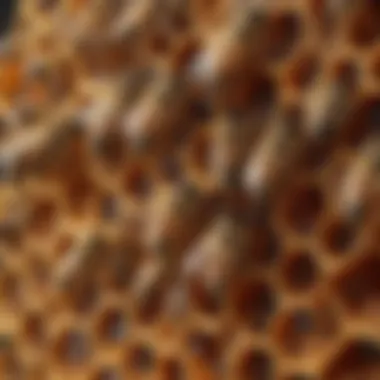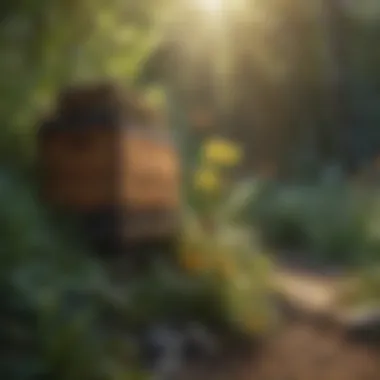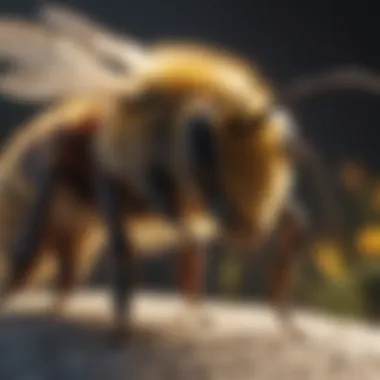Strategies for Safe and Effective Beehive Removal


Intro
When it comes to beehive removal, understanding the delicate balance between human activity and bee preservation is crucial. This guide seeks to provide homeowners with strategies that ensure a safe and effective process for removing beehives while considering the ecological importance of bees. It will cover identification of common pests, prevention techniques, and eco-friendly pest control options. With this information, readers will better understand the importance of thoughtful beehive removal.
Identification of Common Pests
Description of Common Pests
In the context of beehive removal, it is essential to distinguish between different types of bees and wasps commonly encountered. Honeybees, bumblebees, and carpenter bees are among the frequent species found in residential areas. Honeybees are known for their honey production and are often kept intentionally by beekeepers. In contrast, bumblebees play a crucial role in pollination, while carpenter bees, that resemble bumblebees, can cause structural damage by burrowing into wood.
Signs of Infestation
Identifying a bee infestation can be straightforward if you know what to look for. Common signs include:
- Increased bee activity around eaves, attics, or cracks in the walls.
- Buzzing sounds, particularly strong during warm weather.
- Visible building materials such as wax or honeycomb near potential entry points.
Recognizing these signs early can facilitate timely action and potentially reduce harm to the bee population.
Prevention Techniques
Home Maintenance Tips
Preventing beehives from establishing in the first place can save a lot of trouble later. Some practical home maintenance tips include:
- Regularly sealing gaps or cracks on exterior walls.
- Keeping food waste stored securely to minimize attraction.
- Removing standing water, which can attract bees.
These small adjustments can create an environment less conducive to bee nesting, discouraging them from making your property their home.
Environmental Modifications
Adjusting the surroundings can also deter bees from choosing your property as a nesting site. Planting bee-repellent plants like mint or using certain essential oils can help. Additionally, maintaining a neat garden by trimming back shrubs and flowers can limit the appeal of your space to bees.
Eco-Friendly Pest Control Options
Natural Pesticides
For those who find a beehive already established, it is important to consider eco-friendly options. Natural pesticides, such as soap and water mixtures, can disrupt a bee's ability to breathe without causing significant harm to the surrounding environment. Other options include vinegar and essential oils like peppermint or clove, which can repel bees without lethal results.
Organic Pest Control Techniques
Employing organic pest control techniques can be a humane alternative. Some methods include:
- Installing bee traps that do not kill.
- Utilizing live traps to relocate bees safely.
- Enlisting professionals who specialize in eco-friendly beehive removal methods.
These approaches present safer alternatives for both the homeowner and the local bee population.
"Protecting bees while maintaining a safe home is achievable through thoughtful strategies and preventive measures."
Understanding Honeybees
Understanding honeybees is fundamental for anyone considering beehive removal. Knowledge about the characteristics and behavior of honeybees can significantly impact how removal is approached. Effective strategies begin with knowing what honeybees are, why they are present, and how their biology works. This understanding allows for a safer and more humane removal process, ensuring minimal disruption to both the bees and the environment.
When house owners grasp the significance of bees, it can lead to informed decisions. These decisions should balance safety and the ecological importance of honeybees. Recognizing their role in pollination can also promote thoughtful practices that support these essential insects.
Biology of Honeybees
Honeybees, scientifically known as Apis mellifera, exhibit fascinating biological traits. They are social insects, living in colonies that can consist of thousands of bees. Each colony has a specific structure, consisting of a queen, worker bees, and drones. The queen's primary role is reproduction, while the worker bees manage foraging, hive maintenance, and guarding the colony. Drones are primarily responsible for mating.
Honeybees have unique physiological features. They possess a specially designed proboscis for extracting nectar from flowers. Their body structure includes specialized hairy legs for pollen collection. Honeybees communicate through pheromones and dances, signaling the direction and distance to food sources. Recognizing these features aids in understanding their behavior during hive removal.


Role of Bees in the Ecosystem
The importance of honeybees extends beyond honey production. They play a crucial role in the ecosystem by pollinating a wide variety of plants, which is vital for food production and maintaining biodiversity. Approximately one-third of the food humans consume relies on pollination services provided by bees. Fruits, vegetables, and nuts are some of the crops heavily dependent on these insects.
Bees contribute to the health of ecosystems far beyond agricultural settings. They help maintain plant diversity that supports a range of wildlife. This impact on biodiversity enhances ecosystem resilience, ensuring that various species can thrive even in changing environmental conditions.
"Without bees, there would be severe consequences for food production and ecological balance."
Understanding the role honeybees play is essential when discussing removal strategies. It underlines the need for ethical considerations and responsible management practices.
Identifying a Beehive
Understanding how to identify a beehive is crucial for any homeowner or property manager. Recognizing the signs of a beehive not only allows for timely intervention but also prevents potential safety hazards. Identifying bees early helps to mitigate risks of stings, property damage, and even legal implications regarding pest management. By becoming familiar with specific visual cues and analyzing bee behavior, one can make informed decisions about whether and how to remove the hive.
Visual Cues of a Beehive
The first step in identifying a beehive is recognizing its physical characteristics. Beehives often appear as small, dark, and compact structures. They can be found in various locations, such as tree cavities, wall voids, or even under eaves of buildings.
Some visual cues to look for include:
- Honeycomb: This hexagonal structure usually indicates an established hive. If you notice honeycomb shapes in a sheltered area, it is likely a sign of a bee colony.
- Entry Points: Observe for signs around potential entry points like holes or gaps where bees may enter and exit.
- Bee Activity: High traffic of bees around a specific area suggests the presence of a hive nearby.
It is important to approach with caution. A high level of bee activity can indicate a healthy hive, which may result in defensive behavior if disturbed.
Bee Behavior Analysis
Analyzing bee behavior complements the visual identification process. Honeybees exhibit specific behaviors that can reveal the presence of a hive. A few observable behaviors include:
- Flight Patterns: Bees will typically have a consistent flight path to and from their hive. Observing their movements can help identify their home location.
- Feeding Habits: If bees are frequently seen gathering nectar and pollen from flowers nearby, this may indicate proximity to their hive.
- Swarming: Periodic swarming, especially in spring, is a natural behavior for honeybees. Witnessing swarms can be an indicator of a hive that needs management.
It's critical to note that while bees are vital to ecosystems, protecting them during their removal process must align with local regulations regarding management practices.
Familiarizing oneself with these signs not only aids in effectively identifying a beehive but also prepares one for taking appropriate action. If suspicions arise regarding a hive presence, it is advisable to consult professionals to ensure safe removal.
Assessing the Situation
When dealing with a beehive, the first step is to assess the situation. This is crucial for ensuring both the safety of individuals nearby and the fundamental rights of the bees. Understanding the current scenario enables homeowners or property managers to make informed decisions about removal or management. This assessment includes identifying the location of the hive, the species of bees involved, and the size of the colony. Each of these factors impacts how one should proceed.
Safety Concerns
Safety is the highest priority when there is a beehive on a property. Bees can become defensive if they feel threatened and may attack, which poses a risk to individuals nearby. Here are a few important considerations regarding safety:
- Personal Protective Equipment (PPE): Wearing appropriate gear such as bee suits, gloves, and masks can prevent stings. It is essential to ensure that all persons involved in the removal process are adequately protected.
- Distance and Observation: Maintaining a safe distance from the hive is important. Observing the bees' behavior from afar can help assess if they are calm or aggressive.
- Timing: Conducting removal during cooler parts of the day, or in the evening when bees are less active, minimizes the risk of stings.
- Avoiding Sudden Movements: Ensuring that everyone remains calm and moves slowly can reduce the chance of agitating the bees, thereby decreasing the likelihood of an aggressive response.
Legal Considerations
Legal aspects regarding beehive removal should never be overlooked. Some areas have regulations protecting bees due to their critical role in the ecosystem. Here are notable points to keep in mind:
- Local Regulations: Check if there are local ordinances regarding pest control and bee removal. Some communities may require permits for hive removal or prohibit the destruction of active hives.
- Protected Species: In many cases, honeybees may be protected species due to their declining population. Be informed about what species are present in your hive and whether they fall under any protective laws.
- Engagement with Authorities: In certain situations, it might be best to consult with local wildlife authorities or a professional pest control service. These entities can provide guidance that aligns with the law and best practices.
- Liability Issues: If harm comes to individuals or property during removal, liability can fall on the homeowner. Understanding the legal implications helps in making informed choices that prioritize safety and compliance.
In summary, the assessment of the situation surrounding a beehive encompasses both safety and legal aspects. Recognizing these concerns allows homeowners to approach beehive removal with careful planning and due diligence.
Methods for Beehive Removal
Beehive removal requires careful consideration and planning. Understanding the methods available is crucial for effective management. Each technique offers unique advantages and challenges. The goal is always to ensure safety for humans, pets, and the bees themselves.
Professional Bee Removal Services
Engaging professional bee removal services is often the most reliable method. These experts have the training and experience to handle beehives safely. They assess the situation methodically, considering bee behavior and hive location.
Professionals use specialized equipment and techniques, minimizing potential harm. They can relocate the bees to a more suitable environment. This is vital, as honeybees play a crucial role in the ecosystem.


- Benefits of Professional Removal:
- Expertise in handling bees
- Equipment designed for safe removal
- Higher chance of successful relocation
In some regions, licensed professionals abide by strict regulations. They ensure compliance with local laws regarding wildlife protection. This can save homeowners from legal troubles.
DIY Removal Techniques
DIY removal is appealing for many homeowners. However, it carries significant risks. Attempting to remove a beehive without proper knowledge can lead to serious injuries. Thus, safety precautions are paramount.
Before attempting any DIY techniques, consider the following:
- Assess your comfort level with bees.
- Gather necessary protective gear, such as gloves and a bee suit.
- Identify the type of hive and its activity.
Common DIY techniques involve using smoke to calm bees. Smoke masks alarm pheromones, allowing for safer access to the hive. Another method is using insecticidal dust but this can have harmful effects on bee populations.
It is advisable to consult resources like local beekeeping associations. They can offer guidance or alternative solutions that align with bee conservation efforts.
Natural Methods for Beehive Management
Natural methods for beehive management focus on prevention and coexistence. One successful strategy involves maintaining an environment that discourages bees from settling.
- Good Property Practices:
- Inspect properties regularly for potential nesting sites.
- Remove food sources that attract bees, like open garbage or flower beds.
Encouraging biodiversity can also help. By planting flowers that do not attract bees, homeowners can naturally decrease hive formation.
Beekeeping can be embraced as a positive approach. Engaging with local beekeepers can allow house owners to learn about coexistence strategies. Others can take steps to foster bee populations in their area responsibly.
"Understanding bee behavior and preferences is vital for any removal strategy. This knowledge helps maintain a healthy balance in our ecosystem."
Preventing Future Beehives
Preventing future beehives is a crucial aspect of managing your property effectively. A proactive approach helps maintain both safety and ecological balance. By implementing certain strategies, homeowners can significantly reduce the chances of bees establishing hives in unwanted areas. These methods not only protect your living space but also value the vital role bees play in the environment.
Property Inspection and Maintenance
Regular property inspection and maintenance serve as the first line of defense against unwanted beehives. Inspect your property for potential nesting sites. Pay attention to areas such as:
- Eaves and roof overhangs
- Gaps or holes in walls
- Attics or basements that are seldom used
Seal any gaps with appropriate materials like caulk or metal flashing. This prevents bees from entering these problem areas. Regularly trimming shrubs and trees can also help. Cut back branches that hang over your home to eliminate potential access points.
Ensuring your property is clean is equally important. Remove food sources that may attract bees. Keep garbage sealed and regularly clean areas where food debris may gather. A well-maintained yard and home discourage bee activity.
Creating an Unappealing Environment for Bees
Creating an unappealing environment for bees involves more than just cleanliness. Certain strategies can dissuade bees from making your property their home:
- Choose Bee-Resistant Plants: Opt for flowers that are less attractive to bees. Marigolds and sage are good examples as they are known to deter these insects.
- Limit Water Sources: Bees need water, so minimizing standing water in your garden or yard reduces the likelihood of bees settling in.
- Use Essential Oils with Caution: Some essential oils can repel bees, like peppermint and eucalyptus. However, be cautious in using them as they can also attract other pests.
Important: Always remember that bees are essential for pollination. While it’s vital to prevent hives, consider alternatives that do not harm the bees.
In summary, preventing future beehives focuses on consistent property inspection and maintenance, as well as creating an environment that is unattractive to these pollinators. Attention to detail in these areas can save homeowners a lot of trouble in the future. Engaging methods that respect the importance of bees, while also prioritizing personal safety and comfort, are key strategies in effective beehive management.
Importance of Bees in Biodiversity
The significance of bees in maintaining biodiversity cannot be overstated. These insects play a vital role in pollination, which is essential for the reproduction of many flowering plants. This process supports not just the plants themselves but also the entire ecosystem, including the animals and humans that depend on these plants for food and habitat. Without bees, many crops would suffer, leading to lower yields and impacting global food supply.


"Bees are responsible for one out of every three bites of food we take."
In addition to food production, bees contribute to the overall ecosystem stability. Healthy bee populations support diverse plant life, which provides habitats for numerous species. The decline of bee populations can lead to a loss of plant diversity, ultimately affecting wildlife that relies on these plants for survival.
Consequences of Bee Population Decline
The decline in bee populations has serious consequences for biodiversity. Firstly, a reduction in pollination leads to a decrease in both the quantity and quality of fruits, vegetables, and nuts. Many crops, such as almonds and blueberries, are highly dependent on bee pollination. If bees are eliminated, many farms may cease to be viable, leading to economic decline in agricultural areas.
Furthermore, without bees, the plants that rely on them for reproduction may become endangered or extinct. This decline can disrupt food webs, affecting herbivores that feed on these plants and subsequently impacting carnivores that feed on herbivores. The ripple effects throughout the ecosystem can be significant, resulting in a chain reaction of extinction and habitat loss.
Benefits of Protecting Bees
Protecting bee populations is crucial not just for agriculture but also for maintaining ecological balance. By safeguarding bees, we promote healthy ecosystems that can withstand environmental changes. Healthy bee populations improve the resilience of our food supply.
- Economic Impact: Preserving bees can result in a more stable economy for farmers. The economic return on investment in bee protection is substantial, as it directly correlates with increased crop yields.
- Biodiversity: Healthy bee populations enhance plant diversity, ensuring a wide range of plants can grow. This diversity strengthens ecosystems, making them more adaptable.
- Human Health: A diverse ecosystem has direct benefits for human health too. Increased plant diversity improves air quality, provides medicine sourced from plants, and enhances aesthetic beauty in our surroundings.
In summary, the importance of bees in biodiversity extends across various sectors. Their role in pollination helps ensure food security, economic viability, and ecosystem health. The consequences of their decline highlight the urgent need for concerted efforts to protect these essential pollinators.
Ethical Considerations in Beehive Removal
The removal of beehives, while often necessary, also hinges on several ethical factors. Respect for the well-being of bees and their ecological role should guide all actions. Understanding the impact of hive removal on local ecosystems is essential. The ethical considerations encompass humane methods, legal obligations, and community engagement, all of which contribute to a more responsible approach.
The primary focus when discussing ethical considerations is to ensure that bee populations are not unnecessarily harmed. Honeybees play a crucial role in pollination and natural biodiversity. When planning hive removal, it is important to consider humane removal practices. By adopting these practices, individuals and professionals can mitigate stress for the bees, minimizing their risk of death. This is beneficial not only for the bees themselves but also maintains the equilibrium in local ecosystems.
Furthermore, engaging with local beekeepers adds a dimension of ethical responsibility to hive removal. Beekeepers often have the knowledge and resources to relocate hives safely. Collaborating with them offers an effective alternative to extermination. This engagement fosters community relationships, promoting a greater understanding of the importance of bees and the need for safe removal methods.
"Ethical considerations in beehive removal are not just about saving bees, they are about preserving the environment that sustains us all."
The ethics of beehive removal extend beyond individual responsibility. They require a broader view of ecological impact, legal considerations, and community involvement. Together, these elements create a comprehensive framework for responsible beehive management.
Humane Removal Practices
Humane removal practices focus on relocating the bees without causing them harm. Professionals recommend avoiding drastic measures that lead to kill-swarms or poisoning. The first step in humane removal is to assess the hive's location and accessibility. If possible, it is best to wait for the right conditions, such as cooler weather, when bees are less active.
Using tools like smoke can help pacify bees during the removal process. Smoke masks the alarm pheromones that bees emit when threatened. Here are a few humane practices:
- Professional Relocation: Hiring a beekeeper or a qualified bee removal service ensures a safe removal.
- Swarm Collection: If bees are in a swarm, they can often be collected and relocated with minimal disturbance.
- Careful Transport: Using proper containers prevents bees from escaping and getting hurt.
By following these guidelines, homeowners can ensure that the removal process is humane and considerate of the bees' well-being.
Engaging with Local Beekeepers
Engagement with local beekeepers represents an opportunity to utilize expertise that may not be readily available to the average homeowner. Beekeepers often have experience dealing with hive removals and can assist in safe relocation efforts. They may also offer insight into bee behavior, helping to demystify the experience for those unsure about the presence of bees on their property.
Some key reasons to engage local beekeepers include:
- Expertise: Their knowledge of bee management ensures that removal is performed using best practices.
- Community Resources: Beekeepers might have connections to local environmental organizations, facilitating more comprehensive support.
- Sustainable Practices: Collaborating with beekeepers promotes awareness of sustainable practices concerning pollinators.
Establishing communication with local beekeeping clubs can be beneficial. This guarantees that not only are bees relocated safely, but also empowers community members to understand their importance. Involving beekeepers can turn a potential conflict into an educational opportunity for the entire community.
Closure
In the discussion of beehive removal, understanding the conclusion remains pivotal. It synthesizes the overarching themes and practices necessary for effective management. Many homeowners, unaware of the implications, learn that bees play a significant role in ecosystems. By grasping this, they become motivated to adopt mindful approaches when dealing with bee colonies.
The summary encapsulates best practices in removal techniques, legal considerations, and preventive strategies. By following these guidelines, residents can minimize risks involved in beehive removals. This awareness translates to enhanced safety for both individuals and bees. Additionally, engaging with local beekeepers or professionals nurtures a cooperative approach towards nature conservation and sustainable living.
Summary of Best Practices
- Engage Professionals: Whenever possible, leverage the expertise of trained beekeepers or pest management services. They are equipped to ensure humane and safe removal.
- Understand Local Regulations: Before taking any action, familiarize yourself with local laws regarding bee removal to avoid potential legal issues.
- Observe Bee Behavior: Learning to identify bee activity helps in deciding the best time for removal and assessing how to approach the task delicately.
- Inspect Properties Regularly: Maintaining the property to remove factors inviting bees is crucial in minimizing future infestations.
- Consider Eco-Friendly Options: Various natural methods exist to discourage bees, such as planting less attractive flowers or using non-toxic repellents.
Final Thoughts on Bee Management
Bee management extends beyond mere removal; it reflects a broader commitment to ecological health. Recognizing the significance of bees in pollination not only enriches our lives but also fosters biodiversity.
Taking responsible actions ensures that their populations remain resilient. Homeowners should prioritize preventive measures, strike balanced interactions with bees, and contribute to global initiatives aimed at protecting pollinating species. A harmonious living space is beneficial for both humans and the environment. As stewards of our surroundings, we can shape future interactions with nature through informed choices and practices.
"Our choices today determine the biodiversity of tomorrow."







